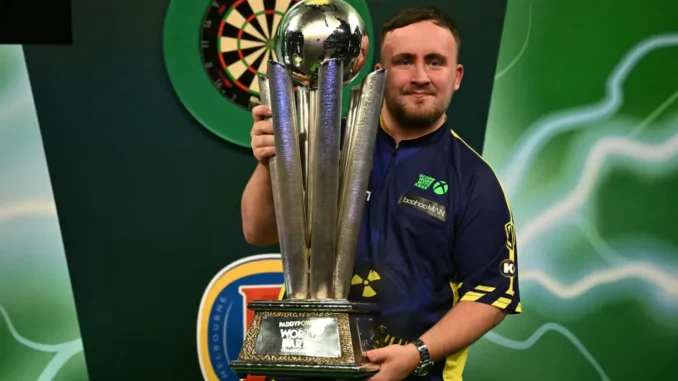
In the high-stakes world of professional darts, where precision meets passion under the glaring lights of packed arenas, a seismic shift is underway. Veteran players, once the unassailable kings of the oche, are now facing an unprecedented challenge from a wave of youthful prodigies. This warning comes amid the meteoric rise of teenage sensation Luke Littler, whose dominance is painting a vivid picture of the sport’s evolving future. As the arrows fly faster and averages soar higher, the old guard may soon find themselves outpaced by a generation brimming with energy, skill, and unyielding ambition.
Darts has long been a game where experience often trumps youth. Legends like Phil Taylor claimed his final world title at the ripe age of 53 back in 2013, while Peter Wright lifted the PDC World Championship trophy in 2022 at 51. These triumphs showcased the enduring prowess of seasoned competitors, who relied on years of honed technique and mental fortitude to outlast their opponents. However, the landscape is changing rapidly, and one former pro is sounding the alarm about an impending “takeover” that could render such late-career victories a relic of the past.
Vincent van der Voort, a 48-year-old darts stalwart who recently lost his Tour Card, has been vocal about this transformation. Drawing parallels to other sports, he emphasizes how the influx of young talent is raising the bar to unsustainable heights for older players. “I think the youth are going to take over darts more and more,” he stated. “You’re going to see fewer older players who can keep going and stay competitive on the Pro Tour. They simply won’t be able to last as long.” Van der Voort likens darts to football, where careers typically peak between 18 and 35, with only rare exceptions extending beyond that. He acknowledges current outliers like Gary Anderson and Peter Wright, who continue to excel at the top level despite their advancing years, and even Raymond van Barneveld, who at 58 is still in the mix. But he predicts these will become anomalies. “The sport is becoming more competitive, younger and bigger,” he added. “If you look at how many 13, 14, 15-year-olds are averaging 90-plus with ease – and sometimes even over 100 – then the old guard are going to find it very difficult. The youth simply have far more energy.”
At the forefront of this youthful revolution stands 18-year-old Luke Littler, whose exploits this year alone have rewritten the record books and captivated fans worldwide. Bursting onto the scene with a stunning PDC World Championship victory in January, where he pocketed a whopping £500,000 prize, Littler has barely paused for breath. He followed that up by claiming the UK Open and the prestigious World Matchplay, completing the elusive Triple Crown that also encompasses the Premier League. His success didn’t stop there; he conquered the Belgian Darts Open and then ventured Down Under to secure back-to-back triumphs at the Australian Darts Masters and the New Zealand Darts Masters. Littler’s blend of raw talent, composure under pressure, and relentless drive offers a tantalizing glimpse into what the future holds for darts—a sport increasingly dominated by players who grew up idolizing the very veterans they’re now eclipsing.
But Littler isn’t alone in this surge. The rise of other young stars underscores the depth of emerging talent. Take the World Cup of Darts, where Daryl Gurney teamed up with 24-year-old Josh Rock to deliver a historic win for Northern Ireland. Rock, now firmly back at the elite level after honing his skills, exemplifies the resilience and potential of this new cohort. Meanwhile, 21-year-old Sebastian Bialecki and 23-year-old Gian van Veen have each notched Players’ Championship victories this year, proving that success isn’t limited to one phenom. Perhaps the most astonishing example is 14-year-old Kayal Baysal from Burnley, who stunned the darts community by winning the World Darts Federation’s 2025 Budapest Classic after just 18 months of serious play. Reflecting on his breakthrough, Baysal humbly noted, “It was a great experience. I played some good darts against some good players,” before adding, “I’ve lots more hard work to do.” WDF secretary-general Nick Rolls was equally impressed, praising the young talent’s rapid ascent. “He’s making rapid progress and his performances in Budapest proved that if you’re good enough, you’re old enough,” Rolls said. “Two of our previous youngest-ever winners were Michael van Gerwen and Luke Littler, so Kaya is in excellent company.”
This influx of precocious ability is fueled by better access to training, global exposure through media, and a competitive circuit that’s more demanding than ever. Young players are entering the fray with higher averages and bolder strategies, often averaging over 100 in practice sessions that would have been unthinkable a decade ago. For fans, this means more thrilling matches, unexpected upsets, and a fresh narrative that keeps the sport vibrant. Yet, it also poses questions about longevity and adaptation for the veterans. Will icons like Anderson or Wright find ways to evolve, or will they gracefully step aside as the next generation claims the spotlight?
As darts continues to grow in popularity, drawing larger crowds and bigger prizes, the “takeover” Van der Voort describes feels inevitable. Littler’s journey from teenage hopeful to world-beater is not just a personal triumph but a symbol of broader change. With talents like Rock, Bialecki, Van Veen, and Baysal hot on his heels, the future of darts promises to be faster, fiercer, and full of surprises. The oche is no longer a domain reserved for the wise and weathered—it’s a battleground where youth reigns supreme, and the arrows of tomorrow are already in flight.
Leave a Reply